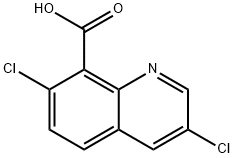3,7-디클로로-8-퀴놀린카복실산 C화학적 특성, 용도, 생산
용도
Quinclorac is a disubstituted quinolinecarboxylic acid that is part of a new class of highly selective auxin herbicides. Quinclorac is used in rice to control dicotyledonous and monocotyledonous weeds
, particularly barnyardgrass (Echinochloa crus-galli). Quinclorac is also used for weed control in turfgrasses.
정의
ChEBI: A quinolinemonocarboxylic acid that is quinoline-8-carboxylic acid in which the hydrogens at positions 3 and 7 have been replaced by chlorines. It is used (particularly as its dimethylamine salt, known as quinclorac-dimethylammonium) as a (rather persisten
) herbicide for the post-emergence control of weeds in rice, grass and turf. It is not approved for use within the European Union.
Pharmacology
The mechanism of action of quinclorac is controversial.
Koo et al. (27) reported that quinclorac inhibited the incorporation
of glucose into the cell wall of maize root cells.
The synthesis of cellulose as well as some hemicellulose
was inhibited at concentrations that inhibited whole plant
growth, leading to the conclusion that quinclorac inhibits
cell expansion by inhibiting glucose incorporation into the
cell wall (27). These authors found that quinclorac inhibited
root elongation in sensitive grasses at concentrations
that inhibited cell wall biosynthesis. Cell wall biosynthesis
in tolerant grasses was much less affected by quinclorac
compared with sensitive grasses (28). Grossmann, on the
other hand, believes that quinclorac acts as an auxinic herbicide
in grasses as well as broadleaf plants, and that its
herbicidal effects are due to production of cyanide (which
is a byproduct of ethylene biosynthesis) and induction of
the plant hormone abscisic acid (29). In this scenario, inhibition
of cell wall biosynthesis would be considered a side
effect, and not the primary cause of herbicidal injury. Differences
in tolerance to quinclorac in this case are solely
due to differences in ethylene induction, in that tolerant
plants do not respond to quinclorac by synthesizing
ethylene (29,30).
신진 대사
Quinclorac has been under development by BASF since
1982, and it has been marketed since 1984, as the herbicide
Facet. Synthesis data are not currently available.
Absorption and uptake of quinclorac is rapid, with 85%
uptake in crabgrass within the first 30 minutes.
Although uptake of quinclorac is rapid, translocation is
generally poor, especially in sensitive plants. Tolerant
species, such as Kentucky bluegrass, tend to transport
more of the chemical away from the area of uptake.
This may, in part, explain how tolerant plants are less
affected by quinclorac. Quinclorac is metabolized very
slowly in both sensitive and tolerant grass species. In
leafy spurge, themajor metabolite found 7 days after foliar
application of quinclorac was a pentosylglucose ester.
In susceptible grasses, early symptoms of quinclorac
activity include rapid chlorosis starting at the elongation
zone of newly expanding leaves. This is followed by
more widespread chlorosis and, eventually, necrosis. On
the other hand, quinclorac seems to affect susceptible
broadleaf plants as an auxinic herbicide. Symptoms
in broadleaf plants begin with induction of ethylene
biosynthesis and epinastic bending of shoots and leaves.
This is followed by growth inhibition, chlorosis, wilting,
and, finally, necrosis.
3,7-디클로로-8-퀴놀린카복실산 준비 용품 및 원자재
원자재
준비 용품







